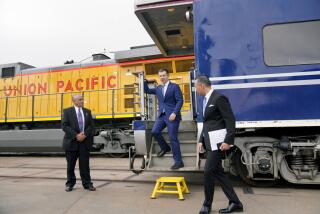Asian Imports Up 20% Over a Year Ago
Asian imports into the U.S. during May rose more than 20% over a year earlier as depressed currencies in the region made goods produced across the Pacific attractive to U.S. consumers.
The Port of Long Beach, the largest U.S. port facility, said imports rose 14% in May from the same month in 1997, while the Port of Los Angeles, the second-busiest, reported a nearly 27% increase.
So far this year, imports have risen more than 17% over the previous year at Long Beach and more than 19% at Los Angeles.
During April, imports through Long Beach rose about 18%, while they rose 21% at Los Angeles.
U.S. exports to Asia fell 8% through Long Beach and almost 11% through Los Angeles during May, as the strengthened dollar made U.S. goods more expensive in Asia.
Last month, exports were down about 6% through Long Beach and about 8% through Los Angeles.
Freight movements are measured in units of 20-cubic-foot equivalents, known as TEUs, the volume of a small shipping container. Long Beach said imports totaled almost 164,000 TEUs, while Los Angeles received almost 157,000.
Long Beach’s exports were more than 84,000 TEUs, while Los Angeles moved more than 68,000.
The brisk pace of traffic across the Pacific has created a serious shortage of shipping containers in Asia and a surplus at U.S. ports. Long Beach said the movement of empty containers back to Asia rose about 94% during May, while the jump at Los Angeles was nearly 47%.
Shipping lines, which are generally filled to capacity from Asia to the U.S. but have fewer loads for the return trips, have begun to add surcharges for moving the empties back to Asia so customers can refill them.
In all, both ports said they moved about 20% more containers in May than in the same month of 1997.
The heavy container volume has strained the capacity of the two primary U.S. railroads that service the two largest ports--Burlington Northern Santa Fe Corp. and Union Pacific Corp. The derailment of a Burlington Northern train last week on a line both carriers use has exacerbated problems in the region and slowed deliveries.
The railroads were already scrambling to find sufficient equipment and personnel to move the increased business at a time when Union Pacific is still trying to recover from what may be the worst rail freight traffic jam in U.S. history.
More to Read
Inside the business of entertainment
The Wide Shot brings you news, analysis and insights on everything from streaming wars to production — and what it all means for the future.
You may occasionally receive promotional content from the Los Angeles Times.










